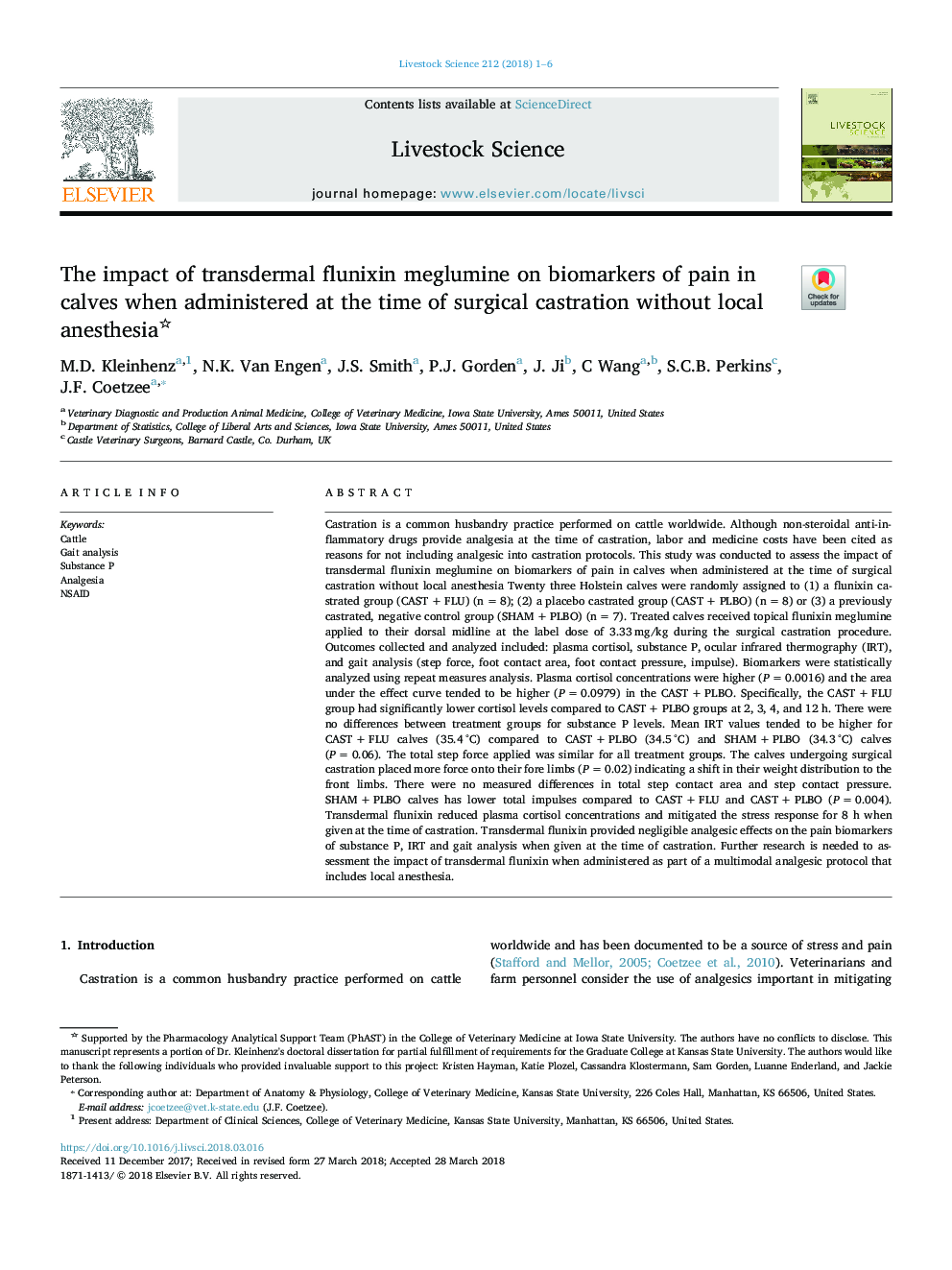| کد مقاله | کد نشریه | سال انتشار | مقاله انگلیسی | نسخه تمام متن |
|---|---|---|---|---|
| 8501958 | 1553920 | 2018 | 6 صفحه PDF | دانلود رایگان |
عنوان انگلیسی مقاله ISI
The impact of transdermal flunixin meglumine on biomarkers of pain in calves when administered at the time of surgical castration without local anesthesia
ترجمه فارسی عنوان
تاثیر فلوئورسین مگلووم ترانس خرمایی بر بیومارکرهای درد در گوساله ها هنگام تزریق در زمان کاستاریک جراحی بدون بی حسی موضعی
دانلود مقاله + سفارش ترجمه
دانلود مقاله ISI انگلیسی
رایگان برای ایرانیان
موضوعات مرتبط
علوم زیستی و بیوفناوری
علوم کشاورزی و بیولوژیک
علوم دامی و جانورشناسی
چکیده انگلیسی
Castration is a common husbandry practice performed on cattle worldwide. Although non-steroidal anti-inflammatory drugs provide analgesia at the time of castration, labor and medicine costs have been cited as reasons for not including analgesic into castration protocols. This study was conducted to assess the impact of transdermal flunixin meglumine on biomarkers of pain in calves when administered at the time of surgical castration without local anesthesia Twenty three Holstein calves were randomly assigned to (1) a flunixin castrated group (CASTâ¯+â¯FLU) (nâ¯=â¯8); (2) a placebo castrated group (CASTâ¯+â¯PLBO) (nâ¯=â¯8) or (3) a previously castrated, negative control group (SHAMâ¯+â¯PLBO) (nâ¯=â¯7). Treated calves received topical flunixin meglumine applied to their dorsal midline at the label dose of 3.33â¯mg/kg during the surgical castration procedure. Outcomes collected and analyzed included: plasma cortisol, substance P, ocular infrared thermography (IRT), and gait analysis (step force, foot contact area, foot contact pressure, impulse). Biomarkers were statistically analyzed using repeat measures analysis. Plasma cortisol concentrations were higher (Pâ¯=â¯0.0016) and the area under the effect curve tended to be higher (Pâ¯=â¯0.0979) in the CASTâ¯+â¯PLBO. Specifically, the CASTâ¯+â¯FLU group had significantly lower cortisol levels compared to CASTâ¯+â¯PLBO groups at 2, 3, 4, and 12 h. There were no differences between treatment groups for substance P levels. Mean IRT values tended to be higher for CASTâ¯+â¯FLU calves (35.4°C) compared to CASTâ¯+â¯PLBO (34.5°C) and SHAMâ¯+â¯PLBO (34.3°C) calves (Pâ¯=â¯0.06). The total step force applied was similar for all treatment groups. The calves undergoing surgical castration placed more force onto their fore limbs (Pâ¯=â¯0.02) indicating a shift in their weight distribution to the front limbs. There were no measured differences in total step contact area and step contact pressure. SHAMâ¯+â¯PLBO calves has lower total impulses compared to CASTâ¯+â¯FLU and CASTâ¯+â¯PLBO (Pâ¯=â¯0.004). Transdermal flunixin reduced plasma cortisol concentrations and mitigated the stress response for 8 h when given at the time of castration. Transdermal flunixin provided negligible analgesic effects on the pain biomarkers of substance P, IRT and gait analysis when given at the time of castration. Further research is needed to assessment the impact of transdermal flunixin when administered as part of a multimodal analgesic protocol that includes local anesthesia.
ناشر
Database: Elsevier - ScienceDirect (ساینس دایرکت)
Journal: Livestock Science - Volume 212, June 2018, Pages 1-6
Journal: Livestock Science - Volume 212, June 2018, Pages 1-6
نویسندگان
M.D. Kleinhenz, N.K. Van Engen, J.S. Smith, P.J. Gorden, J. Ji, C Wang, S.C.B. Perkins, J.F. Coetzee,
